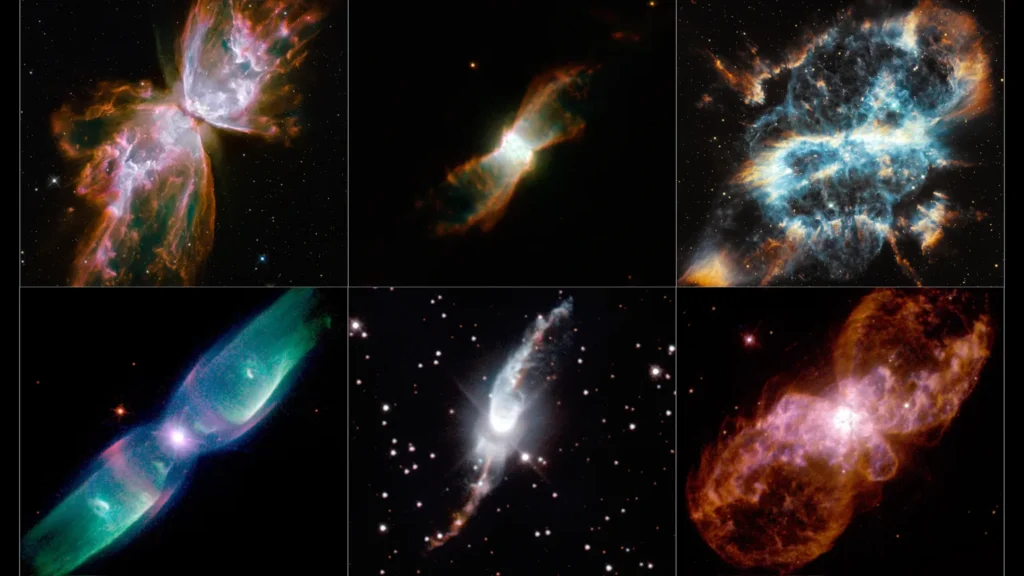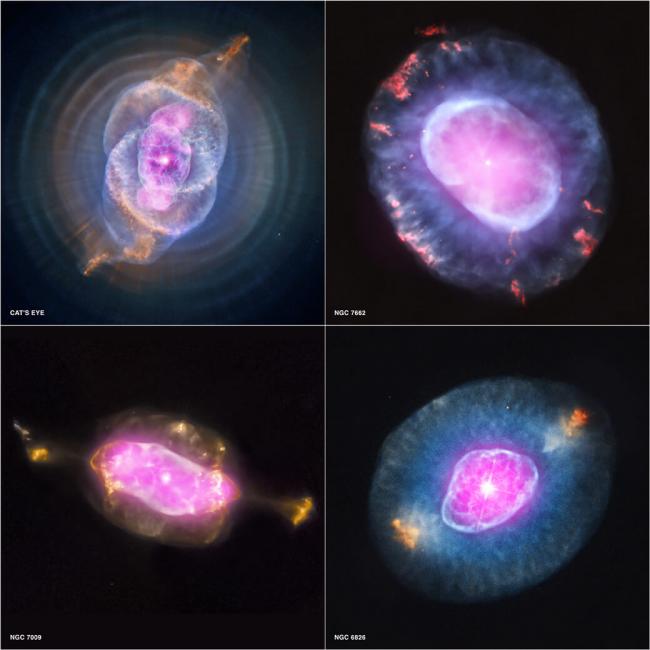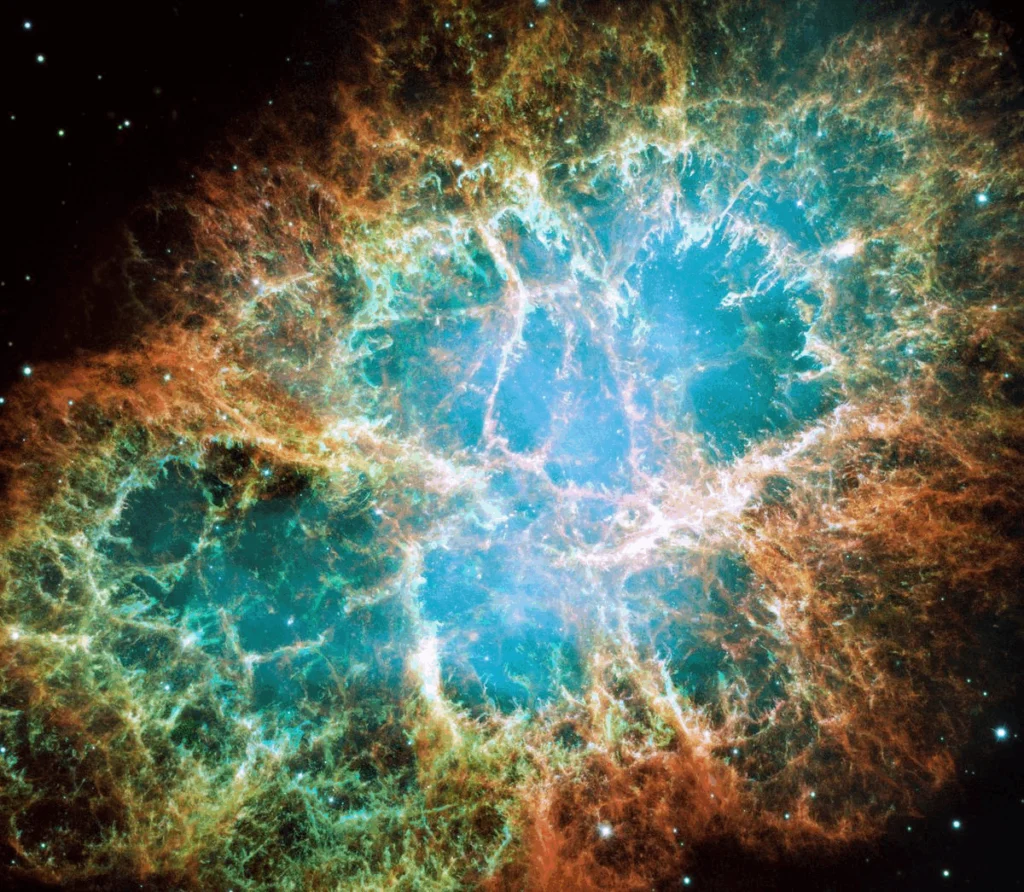When we gaze into the night sky and spot those glowing, cloud-like patches of color, we’re witnessing one of the universe’s most enchanting phenomena: nebulae. These cosmic clouds are far more than visual wonders—they represent both the cradle and the grave of stars. But did you know that our Sun, too, will eventually become one?
At the end of its life, the Sun won’t explode in a spectacular supernova like its massive stellar cousins. Instead, it will gently swell into a red giant, shedding its outer layers in the process. This gradual peeling-away of gas will leave behind a glowing shell of ionized material—what astronomers call a planetary nebula. Though the name is misleading—it has nothing to do with planets—it marks the serene finale of stars like our Sun: not a violent death, but a soft cosmic farewell.
Not all stars meet this fate. Low-mass stars may simply cool into white dwarfs without shedding enough mass to form nebulae. On the other end of the spectrum, massive stars die dramatically in cataclysmic explosions, producing supernova remnants instead. The Sun, being of moderate mass, will follow the most graceful of exits—leaving behind a luminous planetary nebula and a cooling white dwarf core.

The Life of a Star: From Fusion to Final Flame
Every star, from the faintest red dwarf to the most brilliant blue giant, follows a well-defined life cycle. Stars are not eternal—they are born, they evolve, and ultimately, they die.
A star is essentially a massive, incandescent sphere of gas and plasma, held together by gravity and powered by nuclear fusion. Deep in its core, light elements—primarily hydrogen—are fused into heavier ones like helium. This process releases immense amounts of energy, which radiates outward and balances the inward pull of gravity.
As the star ages, it exhausts the hydrogen in its core—the primary fuel for fusion. In stars similar in mass to our Sun, this depletion triggers a dramatic transformation. The core contracts under gravity, becoming hotter and denser, while the outer layers expand. The star enters its red giant phase, a swollen, cooler state where hydrogen continues to fuse in a shell surrounding the inert helium core.
Eventually, the core reaches temperatures high enough to ignite helium fusion, forming carbon and oxygen. But this, too, is temporary. When the helium runs out, fusion halts, and the star can no longer support its expanded layers.
What happens next depends on the star’s mass. In solar-mass stars, the outer envelopes are gently expelled by pulsations and stellar winds during the asymptotic giant branch (AGB) phase. These outflows strip away much of the star’s mass, leaving behind a compact, hot remnant: a white dwarf. The ultraviolet radiation from this exposed core ionizes the ejected gas, creating a glowing shell—the planetary nebula.

Nebulae: Origins in the Depths of Space
Nebulae—those vast, luminous clouds scattered across the cosmos—can arise through a variety of mechanisms. Some form from the diffuse gas and dust that pervade the interstellar medium; others are created by the stars themselves as they evolve and die. Despite their shared name, nebulae are astonishingly diverse in origin, appearance, and behavior.
Interstellar Cradles: Molecular Clouds
Among the most massive and enigmatic nebulae are molecular clouds, vast, cold, and dense regions where interstellar gas begins to clump under gravity. These clouds, composed mostly of molecular hydrogen and sprinkled with cosmic dust, are the stellar nurseries of the universe. Their temperatures are low—often just a few tens of kelvin—allowing gas to condense and initiate the formation of stars. Over time, as gravity pulls material inward, these dense pockets collapse, sparking nuclear fusion and giving birth to new stars. The remaining material may later coalesce into planets, moons, and other celestial debris.
The Aftermath of Dying Stars: Planetary Nebulae
In contrast, planetary nebulae are the elegant remnants of dying stars. As a sun-like star nears the end of its life, it sheds its outer layers, creating a glowing shell of ionized gas. Illuminated by the central white dwarf, this gas radiates in intricate patterns—rings, filaments, or even butterfly-like shapes—offering a haunting glimpse into the future of our own Sun.
Celestial Winds: Herbig–Haro Objects
Young, massive stars can also give rise to nebulae. Through powerful stellar jets, they eject high-speed streams of gas that collide with surrounding material. These interactions create Herbig–Haro objects—compact, glowing patches often arranged in linear chains. While initially thought to be rare, the advent of modern space telescopes like James Webb has revealed dozens within regions like the Orion Nebula. These outflows contribute to enriching the interstellar medium, seeding space with dust and molecules that may later form new nebulae.

Observing Nebulae: Shadows, Silhouettes, and Starlight
Nebulae are among the most breathtaking objects in the night sky, yet their true nature often defies intuition. Though many appear bright and expansive through telescopes—or even to the naked eye—their physical density is astonishingly low. These clouds, while seemingly solid and massive, are in fact composed of incredibly diffuse gas and dust, often less dense than the best vacuum we can produce on Earth.
Some nebulae span hundreds of light-years, dwarfing entire solar systems. The famous Orion Nebula, visible even without a telescope, stretches across an area of sky twice the diameter of a full Moon. Despite its grandeur, the total mass of gas and dust within it is only a few thousand kilograms if compressed to the size of Earth.
So why do these tenuous clouds appear so vividly in our skies? In many cases, embedded hot stars illuminate the surrounding gas, causing it to glow or reflect light—making the nebula visible from Earth. Others are more elusive: faint, diffuse nebulae that only reveal themselves through long-exposure astrophotography or specialized filters that isolate specific wavelengths of light.
Some nebulae, such as those associated with T Tauri stars—young, variable stars still in their formation phase—are lit by the scattered and reflected light of their central sources. These objects, while subtle, hint at the complex interplay between newborn stars and the cosmic clouds from which they emerged.
Nebulae are not only visually stunning but also scientifically invaluable. They serve as laboratories for star formation, as in the Eagle Nebula, home to the iconic Pillars of Creation—a dense region of gas sculpted by stellar winds and radiation. Within such regions, matter coalesces, contracts, and ignites, bringing new stars—and eventually, planetary systems—into existence.
The Three Faces of Nebulae: Emission, Reflection, and Darkness
Although nebulae come in a dazzling array of forms, most fall into one of three primary categories—each defined by how it interacts with light.
1. Emission Nebulae: Cosmic Beacons
Emission nebulae are the glowing hearts of star-forming regions. These nebulae are composed of hot, ionized gas—primarily hydrogen—energized by the intense ultraviolet radiation from nearby young, massive stars. The atoms within the gas absorb this energy, then release it as light. The most common emission is the characteristic red glow of hydrogen-alpha, emitted when electrons drop from the third to the second energy level.
These nebulae often reach temperatures around 10,000 K or higher, and in rare cases, can exhibit green hues from doubly ionized oxygen—requiring extreme conditions nearing 50,000 K. Emission nebulae are most often found in regions of active star formation, where the surrounding clouds are energized by newborn stars.
2. Reflection Nebulae: Ghosts of Starlight
Unlike emission nebulae, reflection nebulae do not glow on their own. Instead, they shine by reflecting the light of nearby stars, particularly hot, young, blue-white stars. These nebulae appear bluish due to the way dust grains scatter shorter wavelengths of light more efficiently than longer ones—similar to why Earth’s sky appears blue.
The primary difference between reflection and dark nebulae often comes down to location. If the dust cloud lies behind or beside a light source, it reflects the starlight and becomes visible. But if that same cloud is positioned directly in front of the light source, it can block it entirely—becoming a dark nebula.
Famous examples of reflection nebulae include the blue veil around the Pleiades cluster and the bluish regions of the Trifid Nebula.
3. Dark Nebulae: Shadows in the Cosmos
Dark nebulae are the most enigmatic of the three. They do not emit or reflect light, but instead absorb it. These clouds of cold, dense molecular gas and dust are so thick that they obscure the light from background stars. The result is a haunting silhouette against a brighter stellar backdrop.
When observed from Earth, these nebulae appear as inky voids—patches of darkness amidst the stars. The Horsehead Nebula, for example, is a dark cloud silhouetted against a luminous emission background. Other well-known dark nebulae include Bok globules and the Pillars of Creation, where stars are being born within obscuring clouds of dust.
Despite their apparent invisibility, dark nebulae are crucial to star formation. Their dense, cold interiors provide the perfect conditions for gravity to initiate the collapse of gas into new stars.
Cataclysmic Nebulae: Traces of Stellar Destruction
Not all nebulae form in calm or gradual processes. Some are born from the universe’s most violent events—where stars die in fire, collide in chaos, or are torn apart by gravity. These are the cataclysmic nebulae, the ashes left behind after titanic stellar transformations.
Supernova Remnants: Echoes of Stellar Death
When a massive star—typically more than eight times the mass of the Sun—exhausts its nuclear fuel, it doesn’t gently fade away. Instead, it collapses under its own gravity in a fraction of a second, triggering a supernova explosion. This outburst briefly outshines entire galaxies and expels the star’s outer layers into space at high velocity.
The aftermath is a spectacular structure known as a supernova remnant. These glowing clouds of expanding gas and shock waves enrich the surrounding space with heavy elements—carbon, oxygen, iron—formed in the dying star’s core. Famous examples include the Crab Nebula, a relic of a supernova observed on Earth in 1054 CE, and the Veil Nebula, a delicate lace of filaments marking a much older stellar death.
At the remnant’s center may lie a neutron star or black hole, depending on the progenitor star’s mass—exotic objects that are themselves the focus of ongoing astrophysical inquiry.
Kilonovae: When Neutron Stars Collide
Even more exotic are kilonova remnants, born when two neutron stars—ultra-dense cores left behind from supernovae—spiral inward and collide. These rare cosmic smashups create intense bursts of gamma rays, along with vast, glowing debris fields rich in the heaviest elements in the universe—like gold, platinum, and uranium.
Kilonovae are not just fireworks; they are factories. Much of the heavy element content of Earth—including the gold in your jewelry and the uranium in nuclear reactors—likely originated in such collisions.
Tidal Disruption Events: Cosmic Shredding
When a star ventures too close to a supermassive black hole, tidal forces can stretch and compress it into a stream of gas—a process known as a tidal disruption event (TDE). The star is literally ripped apart, its material flung outward or swallowed whole. The result can resemble a temporary nebula, glowing in ultraviolet or X-ray light as the gas heats up and swirls into an accretion disk.
These nebula-like structures, though ephemeral, give astronomers crucial insights into the behavior of black holes and the extreme physics of curved spacetime.
White Dwarf Collisions: A Final Firework
Occasionally, two white dwarfs—the dense, inert remnants of sun-like stars—merge or collide. If their combined mass exceeds the Chandrasekhar limit (~1.4 solar masses), the result can be a Type Ia supernova: a thermonuclear detonation so bright and consistent that astronomers use them as standard candles to measure cosmic distances. The debris they leave behind forms yet another kind of supernova remnant, though without the leftover core seen in core-collapse events.
The Faintest Veils: Integrated Flux Nebulae
Amid the tapestry of cosmic light, astronomers have recently begun to identify an elusive class of nebulae that had long escaped detection. These are the Integrated Flux Nebulae (IFNs)—ethereal, ghost-like clouds that drift across the sky, unlit by any nearby star. Unlike traditional nebulae, which glow or reflect starlight from embedded sources, IFNs are illuminated not by a single star, but by the combined light of the entire Milky Way galaxy.
Whispering Shadows in the Galactic Halo
Most IFNs reside in the galactic halo, the vast, sparsely populated region surrounding the Milky Way’s disk. Their location near the north and south celestial poles makes them particularly prominent in deep-sky surveys, and their illumination comes from the integrated background starlight of the galaxy itself—hence their name.
Composed of cold hydrogen gas, carbon monoxide molecules, cosmic dust, and trace chemicals, these nebulae do not emit visible light directly. Instead, they scatter and reprocess the galactic glow, producing a faint luminescence detectable only through ultra-deep, long-exposure imaging—often requiring hours of stacked photographic data to reveal.
One of the most iconic IFNs is the Polaris Flare, a diaphanous cloud near the North Star that swirls like smoke across the sky. Its presence reminds us that space is never truly empty—even the darkest patches of the sky are veiled in unseen structure.
A New Frontier in Nebular Astronomy
Integrated Flux Nebulae were virtually unknown before the 21st century, in part because they are too faint to detect through traditional methods. But as amateur and professional astrophotographers began pushing the limits of exposure and post-processing, IFNs slowly emerged from the cosmic shadows. Today, they represent one of the most exciting frontiers in galactic astrophysics.
These structures not only reveal the three-dimensional texture of the interstellar medium at high galactic latitudes, but also serve as cosmic tracers of dust distribution and magnetic field patterns—vital for understanding foreground contamination in cosmic microwave background (CMB) studies and deep-space cosmology.

Conclusion: Clouds That Shape the Cosmos
From the fiery remnants of dying stars to the quiet whispers of galactic light, nebulae are far more than fleeting clouds in space—they are the cosmic canvases upon which the universe paints its most intricate stories. Each type, whether an emission nebula ablaze with hydrogen light, a dark nebula cloaked in silence, or an integrated flux nebula glowing faintly with the galaxy’s collective breath, reveals a different chapter in the life cycle of stars and the evolution of matter.
What begins as a diffuse molecular cloud may one day ignite into a new sun. What ends in a stellar death may enrich the cosmos with the raw ingredients for planets, life, and future generations of stars. Nebulae, in their beauty and diversity, are the bookmarks of time—tracing the past, illuminating the present, and whispering the shape of things yet to come.
And yet, perhaps the most humbling truth is this: the more deeply we peer into the nebulous folds of space, the more we realize how much remains hidden. With each new wavelength observed and each longer exposure captured, we pull back another layer of the universe’s veil—only to find that the sky, like the story of the cosmos itself, is far from finished.
